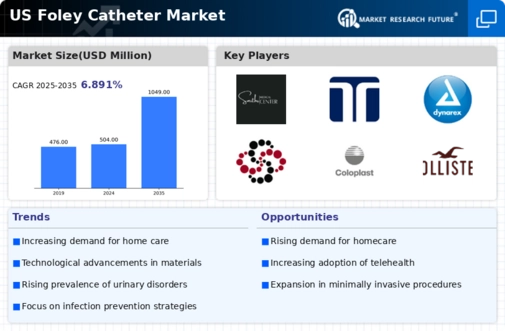The foley catheter market exhibits a dynamic competitive landscape characterized by innovation and strategic maneuvering among key players. Major companies such as Medtronic (US), Boston Scientific (US), and Bard Medical (US) are at the forefront, each leveraging distinct strategies to enhance their market presence. Medtronic (US) focuses on technological advancements, particularly in developing smart catheters that integrate with digital health platforms. Meanwhile, Boston Scientific (US) emphasizes partnerships with healthcare providers to improve patient outcomes through tailored solutions. Bard Medical (US) appears to be concentrating on expanding its product portfolio, particularly in the area of antimicrobial catheters, which are gaining traction due to rising infection control concerns. Collectively, these strategies contribute to a competitive environment that is increasingly driven by innovation and patient-centric solutions.
In terms of business tactics, companies are localizing manufacturing to reduce lead times and optimize supply chains, which is particularly crucial in the current market climate. The competitive structure of the foley catheter market is moderately fragmented, with several players vying for market share. This fragmentation allows for diverse product offerings, yet the influence of major players remains significant, as they set trends that smaller companies often follow.
In October 2025, Medtronic (US) announced a partnership with a leading telehealth provider to integrate its foley catheter technology with remote monitoring systems. This strategic move is likely to enhance patient management and streamline care processes, reflecting a broader trend towards digital health integration. Such collaborations may not only improve patient outcomes but also position Medtronic (US) as a leader in the evolving landscape of connected healthcare.
In September 2025, Boston Scientific (US) launched a new line of foley catheters designed with advanced materials that reduce friction and enhance patient comfort. This innovation is significant as it addresses a critical pain point for patients, potentially leading to increased adoption rates. By focusing on user experience, Boston Scientific (US) aims to differentiate itself in a crowded market, suggesting a shift towards more patient-friendly product designs.
In August 2025, Bard Medical (US) expanded its manufacturing capabilities in the US, investing $10 million to enhance production efficiency for its antimicrobial catheters. This investment underscores Bard Medical's commitment to addressing infection control, a growing concern in healthcare settings. By bolstering its manufacturing infrastructure, the company is likely positioning itself to meet increasing demand while ensuring product quality and reliability.
As of November 2025, current competitive trends in the foley catheter market are increasingly defined by digitalization, sustainability, and the integration of artificial intelligence (AI) in product development. Strategic alliances are becoming more prevalent, as companies recognize the value of collaboration in driving innovation. Looking ahead, competitive differentiation is expected to evolve, with a notable shift from price-based competition to a focus on technological advancements, supply chain reliability, and enhanced patient experiences. This transition may redefine market dynamics, compelling companies to innovate continuously to maintain their competitive edge.
























Leave a Comment